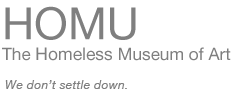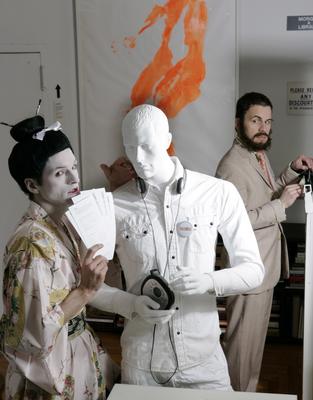Of Closed Doors, Fat Minimalism and Extreme Museum Makeovers
Noterdaeme and Isengart talk about the next chapter of the Homeless Museum.
Recorded in Brooklyn, May 2007
Daniel Isengart: So it's official: HoMu BKLYN is closed to the public.
Filip Noterdaeme: For our opening in March, we had announced the celebration of HoMu's 2nd anniversary. Little did we know that it was also going to be our last opening. The museum had begun to draw too many visitors, and our landlord threatened to evict us if we didn't stop running the semi-public art project out of our rental apartment. Eventually, we had to concede to the forces of landlordism and close.
DI: Are you going to miss the openings?
FN: I loved doing them and I have wonderful memories of it. I mean, how often do you get to discuss art and politics with strangers while lying in bed? But all good things must come to an end, and we've had two very successful years. And we actually have a very neat memento of HoMu BKLYN's history: the one hundred and four weekly charts of our hygrothermograph. Throughout the two years of HoMu BKLYN's public tenure, the museum's ups and downs have registered in beautiful lines of red and blue.
DI: HoMu BKLYN was so many different things: a performance space, an exhibition space, a platform for inter-active installations, and a lab for progressive ideas regarding the museum world. What was your main incentive to create it?
FN: I wanted to show that a museum doesn't need commerce, media hype, or imposing architecture to offer something valuable to its visitors. For me, the whole experience of doing this in my own home was exhilarating and profoundly satisfying. And I know that it meant a lot to other people as well.
DI: Now that HoMu has lost its semi-public platform, what is going to happen to it?
FN: We are going to move HoMu into the next phase and reinvent it for other venues, and through other means. I am already actively looking for spaces that would be willing to host a HoMu show.
DI: You won't dismantle the exhibits?
FN: No, I love living in the set-up of a museum, and there is no reason to change anything. Quite au contraire, I am going to add something: I have ordered two mannequins for HoMu BKLYN. If I can't have real visitors, I shall have fake ones. They will remind me of the people who came to visit the museum. Plus, they will give the exhibits their undivided attention, while becoming part of it.
DI: Very postmodern!
FN: Besides that, I am concentrating on updating the website right now: it will be, once again, HoMu's main platform and archive, just like when I started it in 2002.
DI: Tell us about your projects for this summer.
FN: I have been invited to teach two separate workshops in Kansas City, both of which will revolve around taking an active part in shaping museum culture. One is called "The Undoing and Remaking of Museums," the other "Extreme Museum Makeover." In addition, the Kansas City-based non-profit Grand Arts is sponsoring me to create an original piece for their summer group exhibition, "From the Fat of the Land."
DI: This was your chance to revisit an older idea of making replicas of Donald Judd sculptures out of chocolate (see There's No Place Like HoMu).
FN: We had invited a couple of art bloggers for dinner here at HoMu BKLYN and served them a delicious risotto with chicken livers and rock shrimp. You had prepared some homemade chicken stock for it and stored the fat you had skimmed off the stock in the freezer. It froze into a beautiful, solid golden disk. The next day, Grand Arts told us about the theme for their summer show and asked us if we could create an original piece for it. I just put two and two together: instead of creating Minimalist sculptures out of chocolate, I would use chicken fat.
DI: It's interesting because so many of your ideas seem to be kind of arbitrary at first, but once you look into them, they always make perfect sense.
FN: Well, I have said this before: Minimalism has been co-opted by the art market and turned into eye candy for the wealthy. I am going to subvert this trend with my minimalist chicken fat sculptures, which I will display in a very chic industrial refrigerator with a glass door. The installation will be called "Fat Minimalism." Many people are repulsed by the very mention of chicken fat, which is why it's the perfect material for this project. Minimalism is a fragile oddity, not a commodity. It should inspire awe, not greed.
DI: Would you like to find a full-time exhibit space for HoMu?
FN: I think HoMu will always remain in a vagabond state. I wouldn't mind finding places that welcome HoMu for a while, but I don't think it should ever become a conventional museum in some snazzy building. It would also be interesting to take it out of urban space every now and then. One of my first ambitions was to get the authorization from established museums to let HoMu squat on their rooftops. Now, I'm more tempted by mountaintops.

